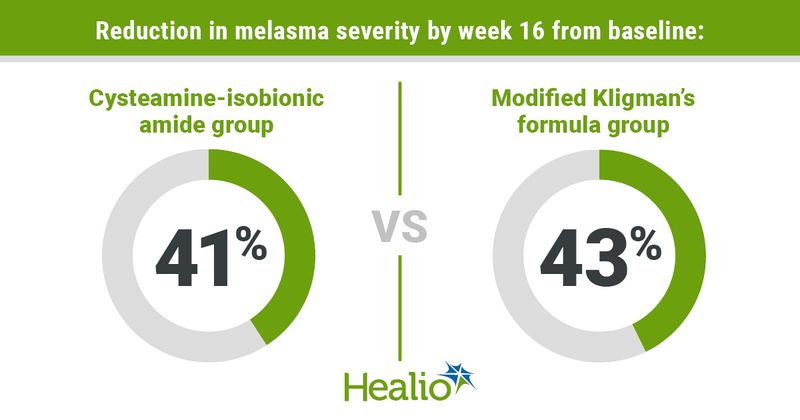Cysteamine isobionic-amide may be alternative to modified Kligman’s formula for melasma
Key takeaways:
- By week 16, both treatment groups saw similar reductions in melasma severity from baseline.
- Cysteamine isobionic-amide vs. modified Kligman’s formula yielded better quality of life outcomes (P < .001).
Cysteamine isobionic-amide combination showed similar efficacy and superior quality of life improvement to modified Kligman’s formula for the treatment of melasma, according to a study.
While modified Kligman’s formula (mKF) — a combination of hydroquinone, retinoic acid and corticosteroids — has been the gold standard treatment for melasma over the last 4 decades, Mukta Sachdev, MD, of the department of dermatology at Manipal Hospital in India, and colleagues wrote that long-term use of mKF is limited due to the risk for adverse effects from long-term exposure to hydroquinone. On the other hand, cysteamine, an endogenous molecule, is the product of natural degradation of L-cysteine biosynthesized during the co-enzyme A metabolism and has intrinsic antioxidant and depigmenting properties.

“Some literature also points to the possibility of these cysteamine formulations being as effective or more effective than mKF,” Sachdev and colleagues wrote. “The present study is a double-blind, randomized and placebo-controlled clinical trial comparing the efficacy of cysteamine isobionic-amide combination with that of mKF for the treatment of melasma.”
Eighty patients were randomly assigned to apply cysteamine-isobionic amide, placebo or mKF once per day for 16 weeks as a treatment for melasma.
At week 4, both cysteamine isobionic-amide and mKF groups showed rapid onset of action in modified Melasma Area Severity Index scores with 22% and 24% reductions from baseline, respectively. Both patient groups also saw equivalent rates of skin pigmentation contrast reduction.
By week 16, results were still comparable between the two active treatment groups with the cysteamine-isobionic amide group and mKF group seeing a significant reduction in melasma severity from baseline vs. placebo (41%, 43% and 4%, respectively; P < .001 for both).
Patients treated with cysteamine isobionic-amide reported significantly better quality of life outcomes by week 16 compared with the mKF group (P < .001). Additionally, positive feedback and satisfaction was more frequent in the cysteamine isobionic-amide group vs. the mKF group.
Ultimately, cysteamine isobionic-amide complex showed equivalent efficacy and superior quality of life improvement compared with mKF for the treatment of melasma, according to the study.
“Taken together the results of this study suggest that cysteamine isobionic-amide could potentially be an acceptable alternative to mKF for the long-term treatment of melasma,” the authors concluded.
